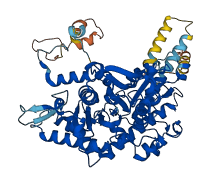Q04792
Gene name |
GAD1 (YMR250W, YM9920.04) |
Protein name |
Glutamate decarboxylase |
Names |
GAD |
Species |
Saccharomyces cerevisiae (strain ATCC 204508 / S288c) (Baker's yeast) |
KEGG Pathway |
sce:YMR250W |
EC number |
4.1.1.15: Carboxy-lyases |
Protein Class |
|

Descriptions
The autoinhibited protein was predicted that may have potential autoinhibitory elements via cis-regPred.
Autoinhibitory domains (AIDs)
Target domain |
|
Relief mechanism |
|
Assay |
cis-regPred |
Accessory elements
No accessory elements
Autoinhibited structure

Activated structure

1 structures for Q04792
| Entry ID | Method | Resolution | Chain | Position | Source |
|---|---|---|---|---|---|
| AF-Q04792-F1 | Predicted | AlphaFoldDB |
6 variants for Q04792
| Variant ID(s) | Position | Change | Description | Diseaes Association | Provenance |
|---|---|---|---|---|---|
| s13-770911 | 38 | V>F | No | SGRP | |
| s13-771469 | 224 | L>I | No | SGRP | |
| s13-771807 | 336 | L>F | No | SGRP | |
| s13-771931 | 378 | H>Y | No | SGRP | |
| s13-772099 | 434 | H>Y | No | SGRP | |
| s13-772376 | 526 | E>G | No | SGRP |
No associated diseases with Q04792
5 regional properties for Q04792
| Type | Name | Position | InterPro Accession |
|---|---|---|---|
| domain | Protein kinase domain | 175 - 473 | IPR000719 |
| domain | Serine-threonine/tyrosine-protein kinase, catalytic domain | 176 - 460 | IPR001245 |
| active_site | Tyrosine-protein kinase, active site | 317 - 329 | IPR008266 |
| binding_site | Protein kinase, ATP binding site | 181 - 213 | IPR017441 |
| domain | Tyrosine-protein kinase, catalytic domain | 175 - 461 | IPR020635 |
Functions
| Description | ||
|---|---|---|
| EC Number | 4.1.1.15 | Carboxy-lyases |
| Subcellular Localization |
|
|
| PANTHER Family | ||
| PANTHER Subfamily | ||
| PANTHER Protein Class | ||
| PANTHER Pathway Category | No pathway information available | |
2 GO annotations of cellular component
2 GO annotations of molecular function
| Name | Definition |
|---|---|
| glutamate decarboxylase activity | Catalysis of the reaction: L-glutamate = 4-aminobutanoate + CO2. |
| pyridoxal phosphate binding | Binding to pyridoxal 5' phosphate, 3-hydroxy-5-(hydroxymethyl)-2-methyl4-pyridine carboxaldehyde 5' phosphate, the biologically active form of vitamin B6. |
2 GO annotations of biological process
| Name | Definition |
|---|---|
| cellular response to oxidative stress | Any process that results in a change in state or activity of a cell (in terms of movement, secretion, enzyme production, gene expression, etc.) as a result of oxidative stress, a state often resulting from exposure to high levels of reactive oxygen species, e.g. superoxide anions, hydrogen peroxide (H2O2), and hydroxyl radicals. |
| glutamate catabolic process | The chemical reactions and pathways resulting in the breakdown of glutamate, the anion of 2-aminopentanedioic acid. |
6 homologous proteins in AiPD
| UniProt AC | Gene Name | Protein Name | Species | Evidence Code |
|---|---|---|---|---|
| P69908 | gadA | Glutamate decarboxylase alpha | Escherichia coli (strain K12) | PR |
| P69910 | gadB | Glutamate decarboxylase beta | Escherichia coli (strain K12) | EV |
| Q9LSH2 | GAD5 | Glutamate decarboxylase 5 | Arabidopsis thaliana (Mouse-ear cress) | PR |
| Q9ZPS3 | GAD4 | Glutamate decarboxylase 4 | Arabidopsis thaliana (Mouse-ear cress) | PR |
| Q42521 | GAD1 | Glutamate decarboxylase 1 | Arabidopsis thaliana (Mouse-ear cress) | SS |
| P54767 | Glutamate decarboxylase | Solanum lycopersicum (Tomato) (Lycopersicon esculentum) | PR |
| 10 | 20 | 30 | 40 | 50 | 60 |
| MLHRHGSKQK | NFENIAGKVV | HDLAGLQLLS | NDVQKSAVQS | GHQGSNNMRD | TSSQGMANKY |
| 70 | 80 | 90 | 100 | 110 | 120 |
| SVPKKGLPAD | LSYQLIHNEL | TLDGNPHLNL | ASFVNTFTTD | QARKLIDENL | TKNLADNDEY |
| 130 | 140 | 150 | 160 | 170 | 180 |
| PQLIELTQRC | ISMLAQLWHA | NPDEEPIGCA | TTGSSEAIML | GGLAMKKRWE | HRMKNAGKDA |
| 190 | 200 | 210 | 220 | 230 | 240 |
| SKPNIIMSSA | CQVALEKFTR | YFEVECRLVP | VSHRSHHMLD | PESLWDYVDE | NTIGCFVILG |
| 250 | 260 | 270 | 280 | 290 | 300 |
| TTYTGHLENV | EKVADVLSQI | EAKHPDWSNT | DIPIHADGAS | GGFIIPFGFE | KEHMKAYGME |
| 310 | 320 | 330 | 340 | 350 | 360 |
| RWGFNHPRVV | SMNTSGHKFG | LTTPGLGWVL | WRDESLLADE | LRFKLKYLGG | VEETFGLNFS |
| 370 | 380 | 390 | 400 | 410 | 420 |
| RPGFQVVHQY | FNFVSLGHSG | YRTQFQNSLF | VARAFSFELL | NSSKLPGCFE | IVSSIHESIE |
| 430 | 440 | 450 | 460 | 470 | 480 |
| NDSAPKSVKD | YWEHPQAYKP | GVPLVAFKLS | KKFHEEYPEV | PQAILSSLLR | GRGWIIPNYP |
| 490 | 500 | 510 | 520 | 530 | 540 |
| LPKATDGSDE | KEVLRVVFRS | EMKLDLAQLL | IVDIESILTK | LIHSYEKVCH | HIELASEQTP |
| 550 | 560 | 570 | 580 | ||
| ERKSSFIYEM | LLALASPQDD | IPTPDEIEKK | NKLKETTTRN | YRGTC |